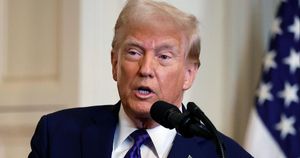India's Economic Outlook and the Impact of Budget 2025
India is poised for remarkable growth, with the government laying strategies through the Union Budget 2025 aimed at revitalizing consumption and supportive investment frameworks. This year's budget indicates not just intent but action to put the Indian economy on the map as one of the world’s top performers.
This budget focuses on tax breaks for the middle class, which is expected to bolster purchasing power. With the government announcing new tax rules, including nil taxes for incomes up to Rs 12 lakh, the aim is clear: reignite consumer spending and support economic recovery through increased disposable income.
Investment experts highlight several sectors likely to see major benefits from this shift. The consumer durables and automotive sectors stand to gain significantly, as lower taxes and financial incentives encourage spending. For example, HDFC Securities mentioned, “The government is banking on rekindling animal spirits and encouraging the private sector to take the lead...” Such sentiments underline expectations of enhanced sales and company revenues across these sectors.
Financial analysts are forecasting improved performance metrics for companies as the benefits of this consumption-driven approach start manifesting. The predictions include substantial growth, with Nifty EPS anticipated to display strong recovery after subdued performance numbers over the preceding quarters.
For the current fiscal year, revenue growth has lagged, leading to concerns about corporate profitability. Acknowledging these worries, JM Financial predicts recovery might take root, saying, “Nil tax up to Rs 12 lakh and rejigging of tax slabs should support consumption…” which hints at the government’s strategic foresight.
Yet, challenges loom. Economists have long expressed concerns about India potentially falling victim to the middle-income trap. The World Bank's reports echo this caution, indicating serious structural obstacles faced by India as it strives for higher-income status among nations.
While the promise of being the world's third-largest economy by 2030 is enticing, the pathway is fraught with risk. Factors like aging demographics and global inflationary pressures necessitate not only governmental response but also grassroots-level initiatives to encourage investment and consumer activity.
Looking forward, the prevalent sentiment around investments appears carefully optimistic. Amid mixed signals, market analysts advocate for strategic selection of stocks, especially within sectors poised to benefit from the revised budget allocations. Aditya Birla Capital states, “We believe the combination of a stable central government and strong corporate balance sheets is unique…” This perspective reinforces the notion of sustained faith within the market.
Equity markets are experiencing heightened fluctuations, where capital allocation, sector resilience, and enduring reforms define potential growth trajectories. Investors are advised to adopt patience and strategic foresight to navigate the current volatility.
The emphasis on consumption over traditional capital expenditure signifies India's effort to tackle immediate economic challenges, testifying to its adaptive fiscal management philosophy. Investors and analysts alike will be closely watching how these budgetary strategies play out on the ground.
With Third World Markets regaining traction, sectoral performances will be pivotal. Upcoming months will witness how successfully these sectors leverage the favorable tax environment to spur growth and investor confidence.
Investors should stay informed, as market dynamics shift, driven by improved economic health indicators stemming from Budget 2025. Acumen and agility will be the name of the game as the country strives to realize its ambitions, both for the economy and for individuals seeking wealth creation within this promising investment environment.



